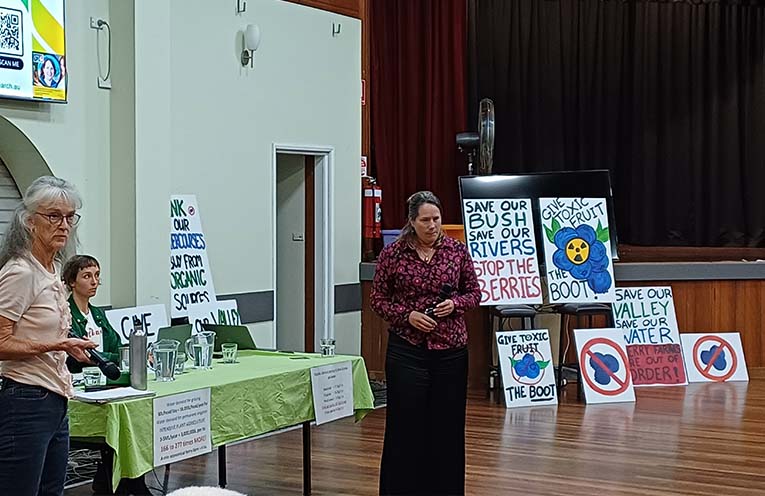
PROFESSOR Kirsten Benkendorff, a well-known marine scientist with Southern Cross University, who has been engaged in several projects on the Mid North Coast, spoke to around 70 people at Macksville RSL last Monday night.
The meeting was organised by the Nambucca Environment Network (NEN), a prominent campaigner against intensive farming practices in blueberry farming, and was attended by Federal Member for Cowper Pat Conaghan and Nambucca Valley Councillor David Jones.
 Advertise with News of The Area today.
Advertise with News of The Area today.It’s worth it for your business.
Message us.
Phone us – (02) 4981 8882.
Email us – media@newsofthearea.com.au
Ms Benkendorff spoke about pesticides and other chemicals, mainly the result of run-off from local farms and sewage operations and their effect on marine life.
She has been engaged in various research studies looking at nearby sites including the Hearnes Lake catchment area of the Coffs Coast and the Clarence River.
Her studies have found worrying amounts of various toxic chemicals including Diuron, atrazine, chlorpyrifos and neonicotinoids like imidacloprid, as well as heavy metals in all sites studied.
Many of the chemicals found are currently banned from use in other countries and some have even been since removed from shelves in Australia.
She detailed some of the problems associated with keeping poisons away from marine wildlife including that large amounts of problem pesticides have probably been stockpiled on some farms and continue to be used or used inappropriately.
She explained how slowly the industry’s regulatory body (Australian Pesticides Veterinary Medicines Association) acted to remove particularly toxic chemicals, taking more than a decade in some cases, with the onus on scientists to prove beyond doubt what harms and through what particular farming practices were being done.
“Testing is costly and we can only screen for a small proportion of known pesticides so it’s easy to miss what you aren’t looking for,” she said.
“When I couldn’t explain a couple of chemicals I found (in the Clarence River), I picked up a few packets of locally grown blueberries from the supermarket shelf and tested them to find them (pesticides thiometon and chlorpyrifos) in large concentrations in the fruit,” she told the room.
According to Ms Benkendorff, regular water testing performed by councils and the seafood industry does not look for pesticides, rather it looks for nutrients, bacteria and chlorophyl or phytoplankton, signatures of the algae problems caused by sewage spills and fertilizer run-off.
“Farmers need education on the harmful effects of many of the chemicals they use,” she explained to NOTA.
She hopes councils can implement effective barriers such as buffer zones, wetlands, and bioreactors between farms and creeks etc. to prevent farm-use chemicals from ending up in waterways.
She also advocates for faster action by the Australian Pesticides Veterinary Medicines Association and government agencies to protect river and marine life.
By Ned COWIE
